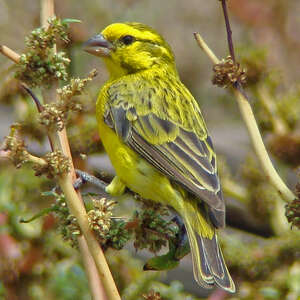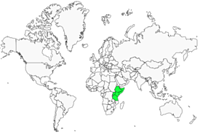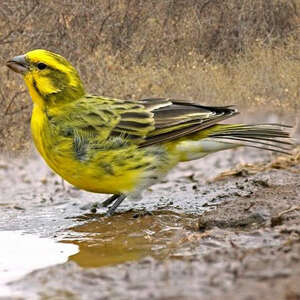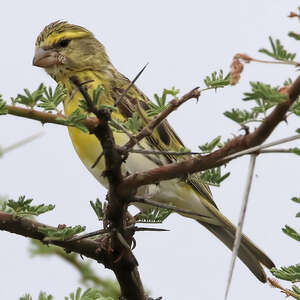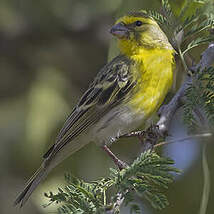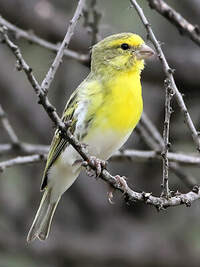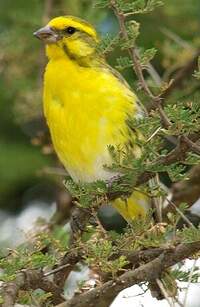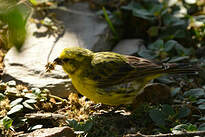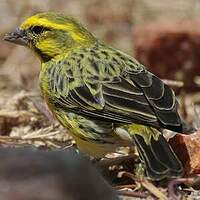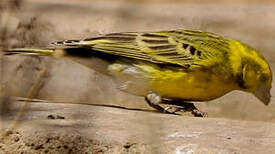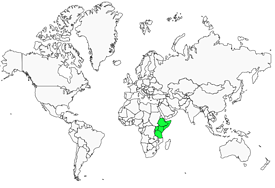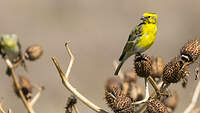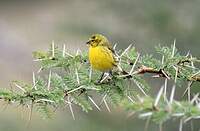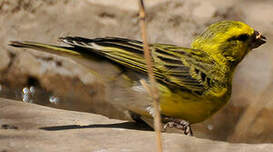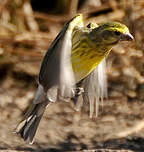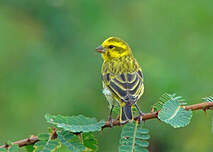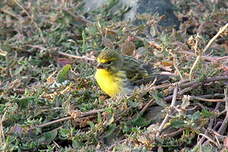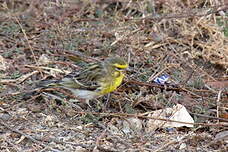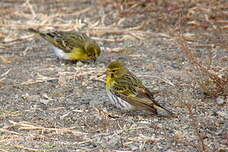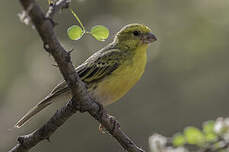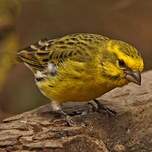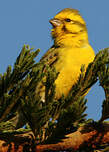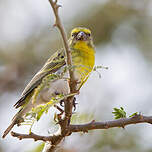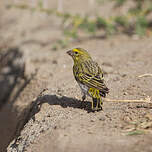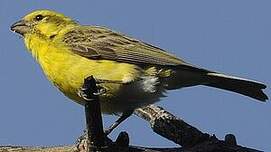White-bellied Canary
Crithagra dorsostriata - Serin à ventre blanc
Identification
Little short-billed bird, the White-bellied Canary is of small to medium size, with a slightly forked tail and a white belly. Previously thought to be conspecific with the St. Helena Canary, it is likely closer to the Mozambique Canary, which is distinguished by its slightly longer tail and more diffuse facial pattern and yellow belly. Three subspecies are currently recognized. The male of the nominate subspecies has the forehead, lores up to the eyebrows and sides of the neck dark yellow. The cheeks and parotids are bright yellow bordered on the top by an ocular band of dark olive and a malaire band of olive-green. The cap and nape are dark olive-green or finely striped greenish-yellow becoming olive-green on the mantle up to the scapulars. The chin and throat to the lower chest are dark yellow. The upper part of the abdomen, the flanks and undertail are pale yellow. The lower part of the abdomen is white. The iris is dark brown to blackish. The short conical beak is dark-horn above and pale-horn below. The legs are blackish or dark gray horn. The smaller coverts are pale yellow olive-green bordered by brown, the medium coverts are blackish-brown fringed with olive-green and the larger coverts are blackish-brown bordered by olive-green. The alula is dark brown, the primaries and secondaries are dark brown with yellowish or greenish-yellow margins and the tertiaries are more broadly bordered with yellowish-green at the tips. The rump is yellow becoming green on the uppertails, the rectrices are blackish-brown bordered with greenish-yellow. The female is similar to the male with greener shades on the parotids, more prominent streaks on the sides of the chest and flanks.The juvenile has pale-brown or brown-ochre head and upperparts, with darker stripes and often yellow or green on the back. The eyebrow is shorter, and the face is off-white. The sides of the cheeks and the malar stripe are gray-brown. The lower chin to chest are light brown-ochre, speckled with dark brown on the lower throat and upper chest, and the lower chest to undertail are white. The rump is yellow, the flight feathers and tail are dark brown with paler borders or yellowish-green. The tips of the median and greater coverts are pale yellowish-brown or ochre. The male of the ssp maculicollis is distinguished by more pronounced whiteness on the belly, and a narrower yellow frontal band than the nominate ssp. The upperparts are slightly greener or tinged with gray-green. The flanks are streaked with blackish. The female is similar to the nominate ssp, with the head slightly paler yellow. The crown and upperparts are tinged with brown, the chin and throat are whitish, and the upper chest is clearly streaked with blackish-brown. S. d. taruensis has upperparts greener than maculicollis. The forehead and eyebrow are much yellower and the white part of the belly is less extensive.
Subspecific information 3 subspecies
- Crithagra dorsostriata dorsostriata (se Uganda, w Kenya and nw Tanzania)
- Crithagra dorsostriata maculicollis (Ethiopia and Somalia through n Kenya to ne Uganda)
- Crithagra dorsostriata taruensis (c, s, se Kenya, ne Tanzania)
Foreign names
- Serin à ventre blanc,
- Serín dorsiestriado,
- canário-de-barriga-branca,
- Weißbauchgirlitz,
- fehérhasú csicsörke,
- Witbuikkanarie,
- Canarino panciabianca,
- vitbukig siska,
- Hvitbukirisk,
- kanárik bielobruchý,
- zvonohlík bělořitý,
- Hvidbuget Sisken,
- valkovatsahemppo,
- gafarró culblanc,
- afrokulczyk białobrzuchy,
- Белобрюхий канареечный вьюрок,
- シロハラキイロカナリア,
- 白腹丝雀,
- 白腹絲雀,
Voice song and cries
The song of the White-bellied Canary is reminiscent of the song of the elegant Goldfinch. More precisely, it is a series of short phrases and sweet and strong musical trills, interspersed with a few harsher notes, often repeated, for example chu-weez, chu-weez or weez-cha, weez-cha, cher-weez-cha and sweet suer weet-sip, sweeur-tsee-tsip, chweeur wee-chip, swee tsur-eep. The call cries consist of whee, suweee, zwee-weez and zweess shrill notes.
Habitat
The habitat of the White-bellied Canary is located in lowlands and sub-mountainous areas. The environment must have dense and difficult to penetrate shrubs and bushes as well as scattered woodlands in meadows and savannahs. It also lives near crops and often near water in Somalia and, conversely, in areas with low to medium rainfall in East Africa. It is usually found between 400 and 1400 meters of altitude, more exceptionally above 2000 meters.
Behaviour character trait
The White-bellied Canary is a resident in its range and partially migratory outside of the breeding season. As a result, it gathers into large colonies in search of feeding areas. The rest of the time it lives alone, in pairs or in small groups of up to six individuals. It looks for its food on the ground, close to low vegetation such as bushes and shrubs.
Reproduction nesting
The White-bellied Canary breeds solitarily. The nest is constructed by the female and is usually in the form of a small open cup.
It can be quite neat but can sometimes be disordered. It is made of plant fibers, lichens, dried herbs, rootlets, twigs, animal fur and feathers, and is constructed between one and eight metres from the ground. It is usually placed in a fork at the end of a horizontal branch of a tree, bush, or in a thick foliage. The female lays between one and four eggs, which she incubates alone. The colour of the eggs can vary from whitish, light blue to blue-green, sometimes they have fine black or reddish-brown spots. There is currently no information on the incubation period or the feeding of the young.Geographic range
The White-bellied Canary is a species from East Africa and the Horn of Africa. Three subspecies are currently recognized. Crithagra dorsostriata dorsostriata is located in south-eastern Uganda, west of Kenya and north-west of Tanzania. Crithagra dorsostriata maculicollis is a northern subspecies, concentrated mainly in the Horn of Africa, in Ethiopia and Somalia. It is also found in northern Kenya and north-eastern Uganda. Crithagra dorsostriata taruensis is located in the central, south and south-east of Kenya and north-east of Tanzania.
Threats - protection
IUCN conservation status
concern
in the Wild
threatened
evaluated
The White-bellied Canary is generally not threatened and is locally common. Escapees from captivity even established a widely common population around Dar es Salaam in Tanzania.
Sources of information
- IOC World Bird List (v14.1), Gill, F and D Donsker (Eds). 2024-04-18.
- Birds of the World, The Cornell Lab of Ornithology
- eBird, Cornell Lab of Ornithology et National Audubon Society
- Finches and Sparrows, Peter Clement
- Birds of the Horn of Africa, Nigel Redman
- Birds of East Africa: Kenya, Tanzania, Uganda, Rwanda, Burundi, Terry Stevenson, John Fanshawe
Other sources of interest
 Specification sheet created on
13/07/2023 by Nathalie Santa Maria
Specification sheet created on
13/07/2023 by Nathalie Santa MariaTranslation by AI Oiseaux.net
published: 16-06-2023 - Updated: 04-07-2023
© 1996-2024 Oiseaux.net
- Accipitriformes
- Aegotheliformes
- Anseriformes
- Apodiformes
- Apterygiformes
- Bucerotiformes
- Caprimulgiformes
- Cariamiformes
- Casuariiformes
- Charadriiformes
- Ciconiiformes
- Coliiformes
- Columbiformes
- Coraciiformes
- Cuculiformes
- Eurypygiformes
- Falconiformes
- Galliformes
- Gaviiformes
- Gruiformes
- Leptosomiformes
- Mesitornithiformes
- Musophagiformes
- Nyctibiiformes
- Opisthocomiformes
- Otidiformes
- Passeriformes
- Pelecaniformes
- Phaethontiformes
- Phoenicopteriformes
- Piciformes
- Podargiformes
- Podicipediformes
- Procellariiformes
- Psittaciformes
- Pterocliformes
- Rheiformes
- Sphenisciformes
- Steatornithiformes
- Strigiformes
- Struthioniformes
- Suliformes
- Tinamiformes
- Trogoniformes

